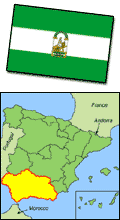 |
 Moron
de la Frontera Moron
de la Frontera
Andalucia

Sevilla
|
The ancient city of Moron
is located 62kms, from Seville, in the southeastern part of
the province, precisely where the flatlands and the hills of
the Sierra Sur converge. In this municipality, with its 430
km squared, the Guadaira River is born; its lands are also
watered by the Salado River. The region's main crops are cereals
and olives.
Its ancient name of Arunci is attributed to the Romans, but
it has been known as Moron since the third century. The city's
prehistoric origins are visible in Paleolithic remains, such
as the dolmens of El Hoyo del Gigante, and other traces of
the Chalcolithic culture. In fact, the archaeological succession
of civilisations is continuous and unbroken from the end of
the Bronze Age up to the Moorish period, which was extremely
important for Moron.
The town's pristine, white-washed landscape is dotted with
manors, palaces, churches and ancient convents which speak
of its past splendour. The excellence of its craftsmen can
be seen in the marble cut from its quarries, the pulpits of
its churches, and its facades, and in the ironwork of its imposing
iron window grills. The Alcazaba still stands, with its Moorish
cistern, among mills, fountains and irrigation canals.
1. THE CASTLE
No other building in Moron bears more eloquent witness to
the splendour of the city under the Moorish caliphate. The
castle of Moron is essentially of medieval construction, made
of rubblework and hewn stone, although it still shows traces
of the original Moorish Alcazaba. It was destroyed by the French
troops in 1812; the surviving section includes a large part
of its rampart walk linking twelve towers, several sections
of the walls and two of the original five gates: the Puerta
de Hierro to the east, with its arch flanked by tall towers,
and the western gate, built in the Almoravid style.
2. PASEO DEL GALLO
The historical city of Moron includes four parks or gardens,
the most interesting of which is this Paseo or promenade located
on the top of a hill near the castle and adjacent to the church
of Saint Michael. From here we can enjoy a sweeping view of
the town. At its centre, surrounded by flower beds, palm trees
and acacias, is a massive piece of modern stonework on which
stands the grotesque statue of the featherless rooster, a symbol
of the old legend of the tax collector who was driven out of
the town in disgrace.
3. CHURCH OF SAN MIGUEL
In 1973, this church was catalogued as a "Site of Historical
and Artistic Value", currently, Bien de Interes Cultural
or Property of Cultural Value. This remarkable building was
begun in 1503. The oldest of the church's three entrances is
the one on the north side, in the 16th century flamboyant Gothic
style. The main, western door was built in 1726 by Diego Antonio
Diaz. The austere facade of the epistle side was built during
the last period of the church's construction, designed by Silvestre
Tirado, as well as the bell tower, which stands on the left
side of the church and strongly resembles the Giralda of Seville.
The church possesses many treasures of religious art, including
furnishings, altarpieces and paintings, goldwork and the ecclesiastical
chest.
 |

See
what tours we have available here! |
Book Organized Tours of Spain
Popular tours sell out well in advance! Don't be
disappointed!
Reduce stress! Don't waste time haggling with the hotel concierge.
Lock in your price! Currency dips & price hikes won't effect you.
Save vacation time! Plan & book now, not when you're there.
Balance your vacation budget! Charge tours on this month's credit card bill. |
|

See
what tours we have available here! |
 |
Related Sites
In
Andalucia - Unbiased information for hotels, golf courses
and car hire in Andalucia, also a full completed guide about
Andalucia, villages, history, parks...
Andalucia.com -
Information about Andalucia, for those interested in this region
of Southern Spain. A structured site for locating useful information
about Andalucia, and Southern Spain.
|
 |




